The “Lower” Salmonberry trail runs west from where both Belding, and Beaver Slide Roads intersect this wild river. It is an overnight walk to reach the confluence of the Salmonberry and the Lower Nehalem. This is one of the most impressive hikes I’ve taken in the last years. The valley is ruggedly beautiful, and to witness what havoc the force of the river wreaked upon the Tillamook railroad is breathtaking, and even a bit scary! This passage through the Coast Range is part of what I have designated the “Southern Route”.
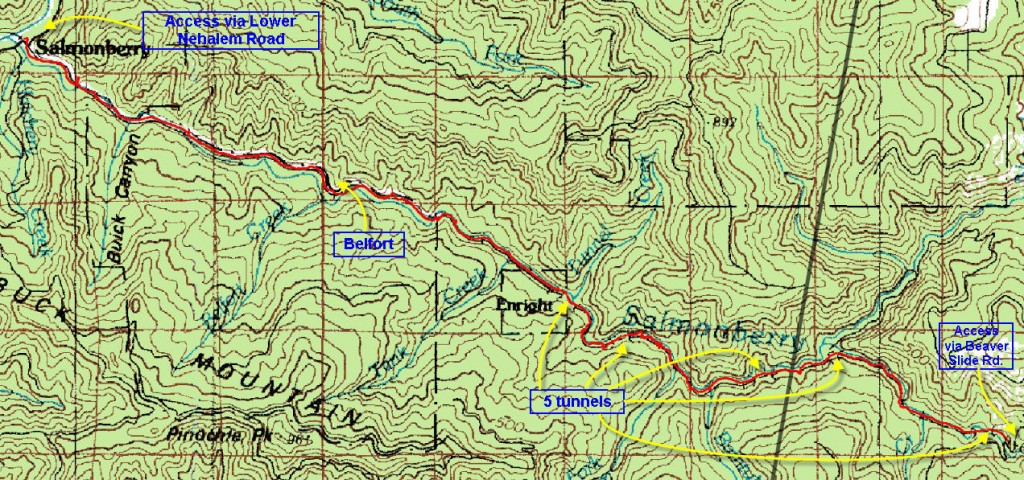 I think that the Salmonberry is one of Oregon’s most
I think that the Salmonberry is one of Oregon’s most 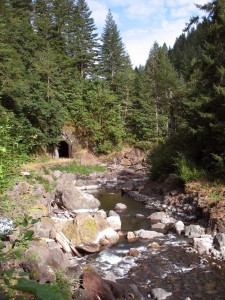 beautiful rivers! It is remote and buried at the bottom of a deep canyon that is a challenge even to the hardiest hikers. It’s innumerable stretches of deep blue-green pools interspersed by tumbling cataracts are literally stunning. But even as we drink in its pastoral grace amid the soft summer breezes, the brutal power of this stream is unmistakable in the raw channel it has carved athwart this wild landscape.
beautiful rivers! It is remote and buried at the bottom of a deep canyon that is a challenge even to the hardiest hikers. It’s innumerable stretches of deep blue-green pools interspersed by tumbling cataracts are literally stunning. But even as we drink in its pastoral grace amid the soft summer breezes, the brutal power of this stream is unmistakable in the raw channel it has carved athwart this wild landscape.
Distance: 15.35 miles; 1.75 miles descent into the valley and 13.6 miles along the river.
Walk duration: 10 – 12 hours walking
Travel time to trail head: These direction assume that you will leave a car at the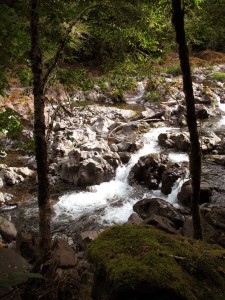 junction of the Salmonberry River and the Nehalem River, and will use a second car to access the top of Beaver Slide Road where the hike starts.
junction of the Salmonberry River and the Nehalem River, and will use a second car to access the top of Beaver Slide Road where the hike starts.
From the Sylvan exit on US 26 (Exit 71) at the top of the West Hills travel 51.5 miles on the Sunset Highway (US 26) to the junction with Foss Road. Travel on Foss Road until you reach the bridge that crosses the Salmonberry – 13 miles.
At this point it is also appropriate to discuss the direction and timing if you plan to leave a car at each end of the hike (highly recommended). To travel from the bridge over the Salmonberry to Beaver Slide Road, the “mid-point” access road, is a 33.4 mile journey requiring about 1 hour and 15 minutes. Retrace your journey up the 13 mile Lower Nehalem River Road to US 26. Turn right heading back towards Portland and travel 10.8 miles until you reach the “Section 10 Road” (aka Wheeler Road). 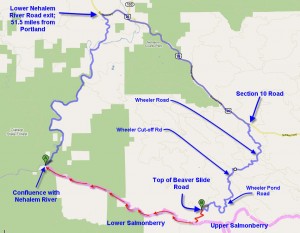 Take a sharp right on this dirt road and proceed up into the wooded heights. After 1.6 miles you will encounter two dirt roads that split off to the left. Drive past these left hand alternatives and continue to travel generally uphill on what is Wheeler Road, but following signs that say Salmonberry Road. Yes, it’s confusing, but I can only surmise they’re indicating that the road will lead you to the Salmonberry Road – which it does eventually…
Take a sharp right on this dirt road and proceed up into the wooded heights. After 1.6 miles you will encounter two dirt roads that split off to the left. Drive past these left hand alternatives and continue to travel generally uphill on what is Wheeler Road, but following signs that say Salmonberry Road. Yes, it’s confusing, but I can only surmise they’re indicating that the road will lead you to the Salmonberry Road – which it does eventually…
Another .7 miles onwards you will pass Lousignant Road on your left – continue straight following the Wheeler Road. A half mile further another road ascends on your left. But we will ignore this side road and proceed straight into what is called the Wheeler Cut-off Road. This road carries you sloping downhill another 1.6 miles southwards, and passes Shields Road on your right about half way down. At the end of the 1.6 miles on Wheeler Cut-off road you will encounter an intersection at the bottom of a steep grade. The right hand option leads you on to the Salmonberry Road. Turn left and a few yards onwards this intersection splits into a three way choice. The extreme right hand option is actually only a minor logging track – ignore it. The other two tracks are both segments of the Wheeler Pond Road (getting tired of too many “Wheelers”, yet?) which originates near the Cochran Pond. At this juncture you will 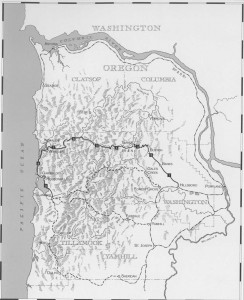 want to take the right hand choice (or middle choice if you include the minor logging road) and follow the southwestern stretch of the Wheeler Pond Road for 4.6 miles rumbling in and out of the ravines that lie above the upper stretches of the Salmonberry river. The river actually runs at the base of the valley you are following. This road has some spectacular spots where it emerges from the woods and traverses large open slopes that provide impressive views of the upper Salmonberry valley. This road always seems longer than it’s actual 4.6 miles. Eventually, you will emerge on a flat clearing that affords views both east towards the Salmonberry River Valley and west towards the deep valley formed by the North Fork of the Salmonberry. On maps this open plateau is marked as the location of Camp Nine – however there is little to suggest any major camp.
want to take the right hand choice (or middle choice if you include the minor logging road) and follow the southwestern stretch of the Wheeler Pond Road for 4.6 miles rumbling in and out of the ravines that lie above the upper stretches of the Salmonberry river. The river actually runs at the base of the valley you are following. This road has some spectacular spots where it emerges from the woods and traverses large open slopes that provide impressive views of the upper Salmonberry valley. This road always seems longer than it’s actual 4.6 miles. Eventually, you will emerge on a flat clearing that affords views both east towards the Salmonberry River Valley and west towards the deep valley formed by the North Fork of the Salmonberry. On maps this open plateau is marked as the location of Camp Nine – however there is little to suggest any major camp.
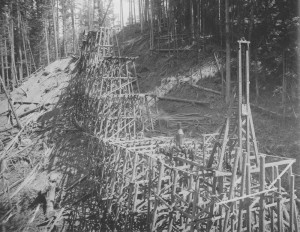 At this junction four roads join. You entered the intersection from the northeast on the Wheeler Pond Road. To your right the Salmonberry Road enters from the northwest and continues across the intersection descending towards the southwest on the far side of the clearing. But we will cross the clearing and veer to the left (southeast) entering a road that has the least traffic of all the choices presented. This is the infamous Beaver slide Road. Carefully follow this road for another .7 miles driving slowly since the road is a bit rough and potholed. After the .7 miles the road reaches a shoulder where the track splits. The least used choice leads straight back into the copse of trees straddling the ridge top and stops. The middle choice dips sharply downhill, and the last choice curves around the end of the ridge to the right. Unless you have a very versatile and powerful four wheel drive “rig” I would suggest parking at this point. Since we will have already left one car at the Nehalem River junction, we are now ready to commence the hike by descending the middle fork of these three choices – which is Beaver Slide Road.
At this junction four roads join. You entered the intersection from the northeast on the Wheeler Pond Road. To your right the Salmonberry Road enters from the northwest and continues across the intersection descending towards the southwest on the far side of the clearing. But we will cross the clearing and veer to the left (southeast) entering a road that has the least traffic of all the choices presented. This is the infamous Beaver slide Road. Carefully follow this road for another .7 miles driving slowly since the road is a bit rough and potholed. After the .7 miles the road reaches a shoulder where the track splits. The least used choice leads straight back into the copse of trees straddling the ridge top and stops. The middle choice dips sharply downhill, and the last choice curves around the end of the ridge to the right. Unless you have a very versatile and powerful four wheel drive “rig” I would suggest parking at this point. Since we will have already left one car at the Nehalem River junction, we are now ready to commence the hike by descending the middle fork of these three choices – which is Beaver Slide Road.
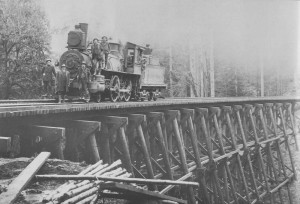 Elevation change: The biggest elevation change occurs on Beaver Slide Road where we lose 1600 ft over 1.75 miles! The grade at times exceeds -30% so that it’s a struggle to keep from overbalancing downwards and slipping on the rough gravel surface. No wonder it’s called the Beaver Slide Road – it’s no exaggeration. The rest of the hike only loses about 500 feet in elevation over the remaining 13.6 miles along the Salmonberry River.
Elevation change: The biggest elevation change occurs on Beaver Slide Road where we lose 1600 ft over 1.75 miles! The grade at times exceeds -30% so that it’s a struggle to keep from overbalancing downwards and slipping on the rough gravel surface. No wonder it’s called the Beaver Slide Road – it’s no exaggeration. The rest of the hike only loses about 500 feet in elevation over the remaining 13.6 miles along the Salmonberry River.
Brief summary: This has got to be one of the most impressive hikes in the north Coast Range, or even across all of Oregon. In my opinion the Salmonberry is one of the most beautiful and awesome rivers in the state. It is said to be among the best fishing streams in the region, though we only saw fingerlings on our way through. The hiking is strenuous and requires strong ankles as you will be bushwhacking steep detours and walking across many patches with large rocks. The walking along the railroad tracks can also be tiring as the sleepers are arranged to produce the maximum discomfort to pedestrians… But you will come away from this trip with a new found respect for the unbelievable power of an untrammeled mountain river.
For purposes of better organizing the trail description, I have segmented the hike into six segments:
- Beaver Slide Road descent to the Salmonberry River.
- From the base of Beaver Slide Road west to Tunnel 29.
- From Tunnel 29 to Tunnel 31.
- Enright segment, including Tunnel 32
- Belfort segment.
- Nehalem confluence.
1. Beaver Slide Road descent to the Salmonberry River.
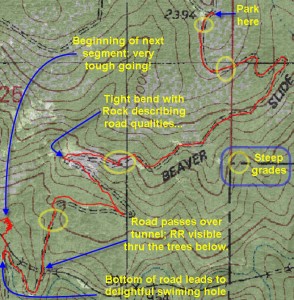 Right from the beginning, where the road tips off the end of the ridge at about 2400 ft in elevation it’s a steep descent. The first third of the descent winds about in a generally southeasterly direction passing through a mixed alder and hemlock forest. After about .4 miles the trail turns in a southwesterly direction and traverses down the steep incline heading towards the west.
Right from the beginning, where the road tips off the end of the ridge at about 2400 ft in elevation it’s a steep descent. The first third of the descent winds about in a generally southeasterly direction passing through a mixed alder and hemlock forest. After about .4 miles the trail turns in a southwesterly direction and traverses down the steep incline heading towards the west. 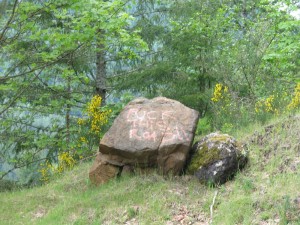 This traverse gets progressively steeper with the grade in the -25% to 29% range and at places approaching a 48% grade!
This traverse gets progressively steeper with the grade in the -25% to 29% range and at places approaching a 48% grade!
At the corner a huge rock marks the switchback and spray paint commentators have been kind enough to express their true feelings about the Beaver Slide Road.
Below the rock we’re traveling in a southeasterly direction along 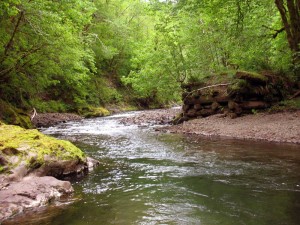 the flank of the mountain, but it soon switches back to a westerly descent. At this point we reach the only relatively level area in the climb but as we turn the corner the road drops precipitously again and begins a straight line slide along a ridge. On the right side you can glimpse the RR tracks amongst the trees, and on the left hand side you can hear the river lashing its way down the steep trench at the bottom. The tracks actually pass under Beaver Slide Road. If you were to arrive here in mid-winter in the midst of a storm you would be walking into what amounts to a 21 mile washing machine churning boulders, tree trunks and huge
the flank of the mountain, but it soon switches back to a westerly descent. At this point we reach the only relatively level area in the climb but as we turn the corner the road drops precipitously again and begins a straight line slide along a ridge. On the right side you can glimpse the RR tracks amongst the trees, and on the left hand side you can hear the river lashing its way down the steep trench at the bottom. The tracks actually pass under Beaver Slide Road. If you were to arrive here in mid-winter in the midst of a storm you would be walking into what amounts to a 21 mile washing machine churning boulders, tree trunks and huge 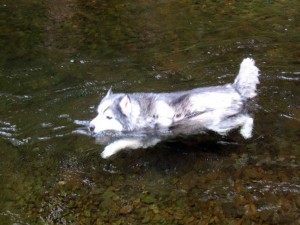 maelstroms between the steep embankments – bending and crushing everything in its way!
maelstroms between the steep embankments – bending and crushing everything in its way!
But during more clement weather this hard to reach river bottom is a place of solitary beauty. At the base of this road take some time to rest and if the weather permits dip your skinny butt in the blue-green waters of the Salmonberry!
2. From the bottom of Beaver Slide Road (west) to Tunnel 29.
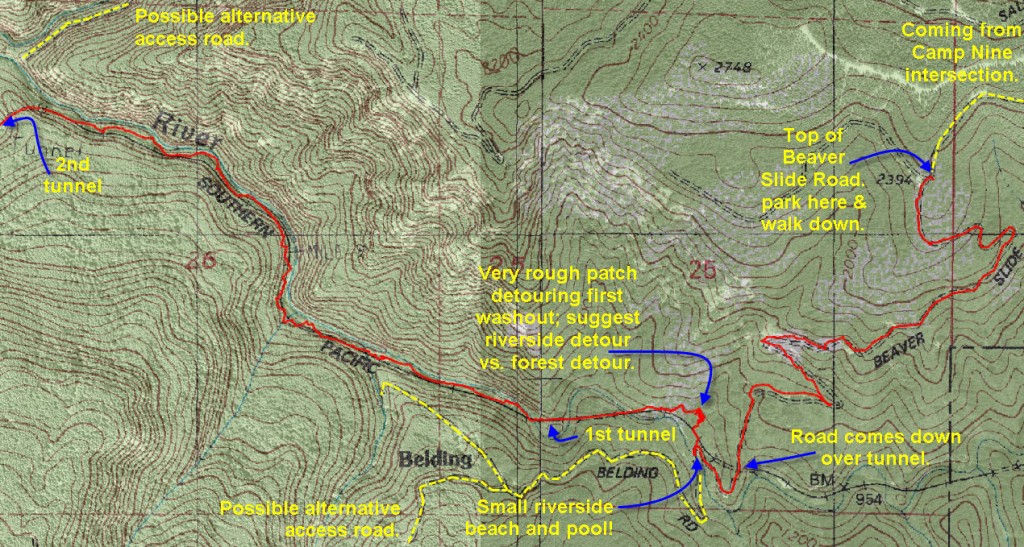 It always seems like there’s just not enough time to sit quietly by this river to appreciate the untouched world that thrives in this green chasm. I sometimes feel as if I could almost merge with nature’s rhythms – if only I might be allowed to sit and contemplate the river flowing by for just little longer…
It always seems like there’s just not enough time to sit quietly by this river to appreciate the untouched world that thrives in this green chasm. I sometimes feel as if I could almost merge with nature’s rhythms – if only I might be allowed to sit and contemplate the river flowing by for just little longer…
The woods are lovely, dark and deep.
But I have promises to keep,
And miles to go before I sleep,
And miles to go before I sleep.
And these next miles are the toughest on this hike.
Returning back to the railroad tracks we now head west (not through the Tunnel 27 over which we descended). Almost immediately the route is blocked by mangled tracks and a river ruined railroad grade. On the left side of the track you will see a sign board (devoid of any postings) . Immediately behind it a rough track descends down to the riverbed. Follow that if the water is not too high. At the farther end of the washout you will find a ladder that takes you back up to the remaining tracks. If you’re accompanied by a four footed creature, continue on and eventually beyond the end of the washout you will find a switch-back trail that ascends to the train tracks. I found it easier to walk down the river for parts of this trek…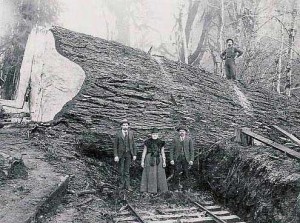
Going through the woods above the track is as near to impenetrable as it gets in the Coast range! On the steep slope above the track we encountered a virtual log jam of trees, trunks, rocks, gullies, branches and moss covered everything. It was often hard to determine where the ground is located as we clambered from one rotten tree trunk to a boulder and through the vine maple to another slanting log. Like caterpillars we tried to navigate through this decaying shoal of forest debris piled deep into the steep slope. The detour is probably no longer than a couple of hundred feet, dropping back down to the rail road bed just beyond the ruined embankment. But this tangled detour could take up to 30 minutes to cross. 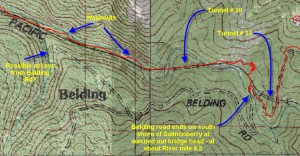
Immediately after this initial scramble the tracks cross the Salmonberry and pass through the first tunnel (Tunnel 28) west of Beaver Slide 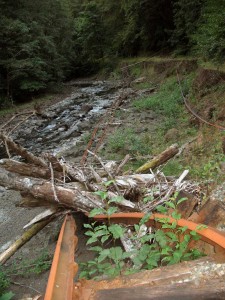 Road. Beyond the tunnel the tracks cross the river twice spanning a loop in the river course – ending up following the south shore of the river. Two creeks flow into the Salmonberry along this relatively straight stretch and as a consequence it is clogged with damaged track and grades requiring frequent detours through the tumbled landscape and forest detritus.
Road. Beyond the tunnel the tracks cross the river twice spanning a loop in the river course – ending up following the south shore of the river. Two creeks flow into the Salmonberry along this relatively straight stretch and as a consequence it is clogged with damaged track and grades requiring frequent detours through the tumbled landscape and forest detritus.
The first of these creeks is Belding Creek. Belding Road, a rough access road descends 11.5 miles from just below Roger’s peak (elev. 3706 ft.) and leads nearly down to the RR grade. The top end of this road can be accessed from Lee’s Camp and the roads that encircle Roger’s peak – about a 3 mile hike to the top of Belding Road! The Belding Road dead-ends opposite the bottom of Beaver Slide Road at the washed out bridgehead.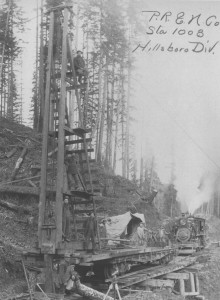
Both at Belding Creek and Jones Creek (a quarter mile west of Belding Creek) you will encounter severe washouts requiring scrambles to circumvent the carnage. For the next mile the route bends northwards and traverses several more washouts. It is mostly impossible to gauge where the trail goes beyond the next few yards, as washouts occur in almost every bend along the river. At this point it would be useful to note that some kind soul has marked the best route with a blue arrow – we found 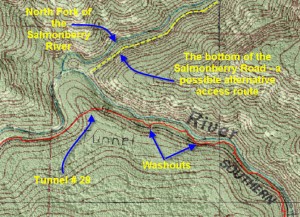 these indicators to be pretty reliable – at least until the next flood rearranges the boulders…
these indicators to be pretty reliable – at least until the next flood rearranges the boulders…
Almost a mile beyond Belding Creek the river turns and resumes a north-westerly course – albeit constantly swerving back and forth across the narrow canyon that contains the torrent. There are two 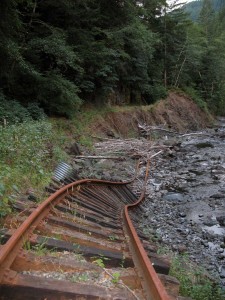 more significant washouts in this section as you approach the second tunnel (Tunnel 29). It is important to note that this tunnel cuts through a ridge at the end of which is the confluence of the North Fork of the Salmonberry River. If you follow the rail spur around the bend (avoiding the tunnel) you can climb down to the riverside at the point where the spur line bends around the end of the ridge. Until 1967 there used to be a big log bridge that spanned the Salmonberry at this point, but the railroad dynamited it to prevent vehicular access to the rails. A rough track used primarily by elk and the occasional hunter or fisherman descends above the North Fork down to the confluence with the main stem of the Salmonberry River. A lovely little meadow at the end of this elk trail overlooks the confluence.
more significant washouts in this section as you approach the second tunnel (Tunnel 29). It is important to note that this tunnel cuts through a ridge at the end of which is the confluence of the North Fork of the Salmonberry River. If you follow the rail spur around the bend (avoiding the tunnel) you can climb down to the riverside at the point where the spur line bends around the end of the ridge. Until 1967 there used to be a big log bridge that spanned the Salmonberry at this point, but the railroad dynamited it to prevent vehicular access to the rails. A rough track used primarily by elk and the occasional hunter or fisherman descends above the North Fork down to the confluence with the main stem of the Salmonberry River. A lovely little meadow at the end of this elk trail overlooks the confluence.
4. From Tunnel 29 to Tunnel 32.
Passing through Tunnel 29 we emerge into a continuation of the narrow valley down which the Salmonberry flows. About 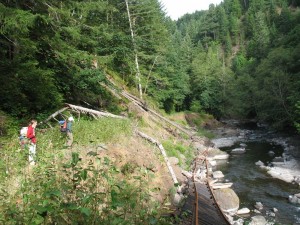 1/3 of a mile from the tunnel you will encounter a major logjam that has eroded the southern embankment. At 3/4 of a mile you will enter Tunnel 30. About a half mile from the tunnel exit you will cross Bathtub creek which has formed a kind of rock strewn delta populated with waist high alders. Needless to say the railroad was swept into the river at this point. Blue arrows help guide you through the rocky foliage.
1/3 of a mile from the tunnel you will encounter a major logjam that has eroded the southern embankment. At 3/4 of a mile you will enter Tunnel 30. About a half mile from the tunnel exit you will cross Bathtub creek which has formed a kind of rock strewn delta populated with waist high alders. Needless to say the railroad was swept into the river at this point. Blue arrows help guide you through the rocky foliage.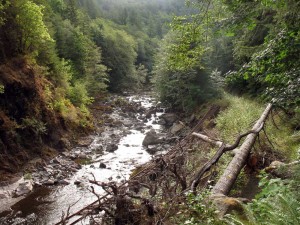
Just past Bathtub creek the narrow defile turns in a north-westerly direction. At this point you will encounter yet another massive detour. This requires a substantial scramble up the hillside and a tricky traverse about 30 feet above the prior embankment. At one point a rope dangles from a log presumably to help hikers descend. We heeded the “blue arrow” and continued to ascend and surmounted the blockage by climbing over it.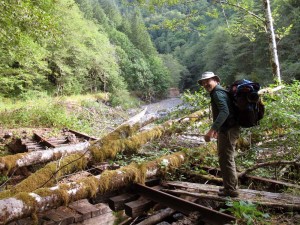
A quarter mile further is the mouth of Ripple Creek which is a major tributary flowing in from the south. The next mile between Ripple Creek and Tunnel 31 proved to be full of detours, bushwhacks and strenuous hiking.
5. Enright Segment, including Tunnel 32.
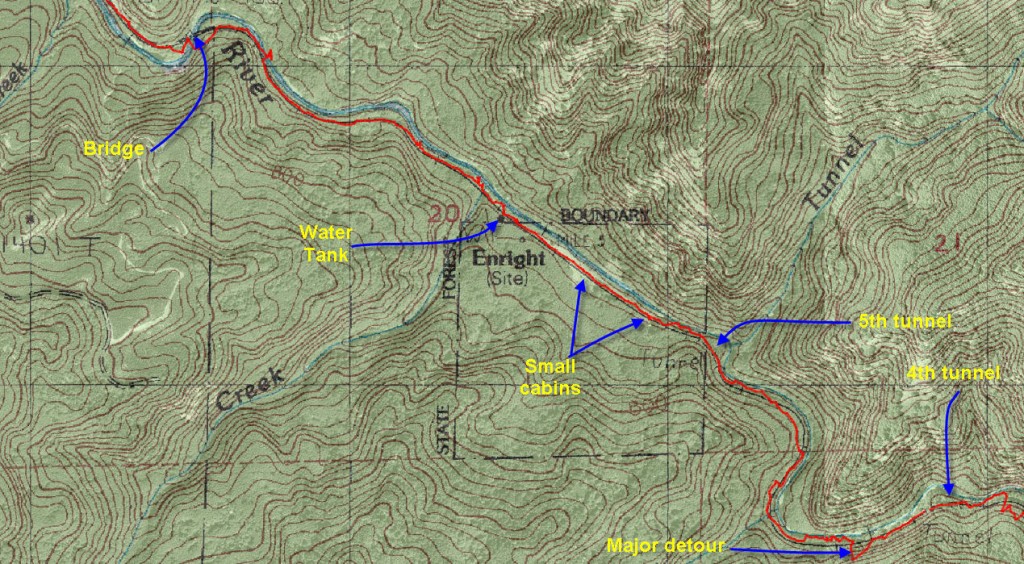 And on the far side of Tunnel 31 the terrain continued to be broken and requiring at least one significant detour. Thereafter the river seemed to have depleted its ferocious violence and the railroad embankment had survived mostly intact. The occasional stream
And on the far side of Tunnel 31 the terrain continued to be broken and requiring at least one significant detour. Thereafter the river seemed to have depleted its ferocious violence and the railroad embankment had survived mostly intact. The occasional stream 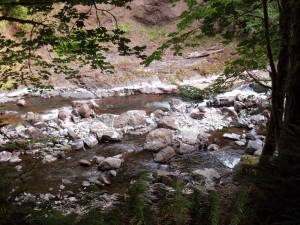 or creek entering the river was likely to wash away the rail infrastructure, but at least the detours were no longer 50 foot scrambles up the steep embankments. From Tunnel 31 to Tunnel 32 was a distance of about 1 mile.
or creek entering the river was likely to wash away the rail infrastructure, but at least the detours were no longer 50 foot scrambles up the steep embankments. From Tunnel 31 to Tunnel 32 was a distance of about 1 mile.
As we approached Tunnel 32, across from Tunnel Creek, the boulder strewn waterway widened and even developed sandy stretches of riverside beaches. To get to this point count 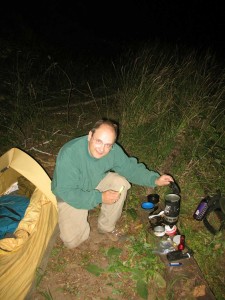 on at least four hours of hiking, which means you will need to depart the top of Beaver Slide road no later than 4 Pm.
on at least four hours of hiking, which means you will need to depart the top of Beaver Slide road no later than 4 Pm.
Alternatively, you can go through Tunnel 32 and on the far side it is possible to double back towards the point of the ridge where there is a nice flat plateau overlooking the river. It overlooks a beautiful set of rapids with small pools interspersed (see picture above) 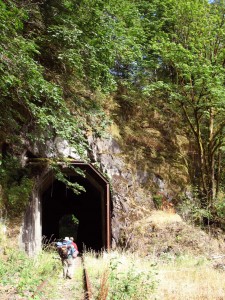 .
.
Night can fall quickly in these narrow valleys, so don’t tarry too long or the light will fade to leave you cooking in the dark. Be careful with your food stuffs. Remember that you’re deep in the Coast Range which is also home to a considerable population of black bears who might be tempted to feast on your provisions if left casually strewn about.
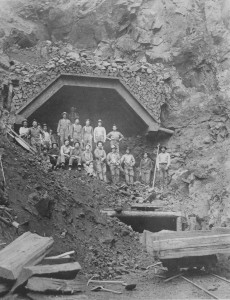 During the storm of 2007, Tunnel Creek which enters the Salmonberry at the end of this ridge flooded and its debris blocked the main stem of the Salmonberry with an enormous log jam. This obstruction caused the river to back up forcing it to flow through Tunnel 32. As the force of the river struggled to surge through the tunnel the water rose to a height of 25 feet above the mouth of the tunnel. It scoured the rock face of all vegetation as it pushing boulders the size of Volkswagens through the tunnel! Once the logjam burst, the river redistributed the accumulated sand and material all along the straight stretch of river downstream – raising the bed of the river by almost 3 feet.
During the storm of 2007, Tunnel Creek which enters the Salmonberry at the end of this ridge flooded and its debris blocked the main stem of the Salmonberry with an enormous log jam. This obstruction caused the river to back up forcing it to flow through Tunnel 32. As the force of the river struggled to surge through the tunnel the water rose to a height of 25 feet above the mouth of the tunnel. It scoured the rock face of all vegetation as it pushing boulders the size of Volkswagens through the tunnel! Once the logjam burst, the river redistributed the accumulated sand and material all along the straight stretch of river downstream – raising the bed of the river by almost 3 feet.
Tunnel 32 proved to be the turning point after which the hike became more predictable and the detours less strenuous.
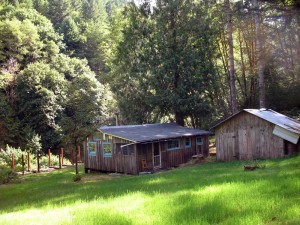 The valley seemed to open up a bit on the western side of Tunnel 32, and the route straightened in a more or less northwesterly direction. Not long after emerging from the tunnel ( about .1 mile) we suddenly came upon small cabins nestled into the hillside above the rail road tracks. The first of these cabins belongs to Don Hennig, whose father acquired it in 1965. Probably built in the 1930’s during the heyday of the logging activity in this area, it served as a bunkhouse for the loggers and railroad hands that operated out of the isolated hamlet of Enright. Today the community is comprised of a handful of of remote cabins, but prior to the Tillamook Fire burned off most the timber, Enright had a population of nearly 400 people.
The valley seemed to open up a bit on the western side of Tunnel 32, and the route straightened in a more or less northwesterly direction. Not long after emerging from the tunnel ( about .1 mile) we suddenly came upon small cabins nestled into the hillside above the rail road tracks. The first of these cabins belongs to Don Hennig, whose father acquired it in 1965. Probably built in the 1930’s during the heyday of the logging activity in this area, it served as a bunkhouse for the loggers and railroad hands that operated out of the isolated hamlet of Enright. Today the community is comprised of a handful of of remote cabins, but prior to the Tillamook Fire burned off most the timber, Enright had a population of nearly 400 people.
It was during this phase of the hike that we began to notice that a band of taggers had preceded us over the years. “Ogre” had signed his name all the way up the Salmonberry to Cochran Pond in 2008 as part of a 42 mile hike (presumably 21 miles up the river and back). Evidently he returned the following year with his associates including Gime, Depths and Bumjug, among others. Gime, I am told, is well known as a Portland graffiti artist… We found the painted commentary amusing.
The water tower at Enright sported one of the best signature pieces by Gime. In 1915 there were seven such water tanks along the way, to provide ample water for the engines to exert sufficient power to navigate the 3% grade that began just beyond Enright.
6. Belfort segment.
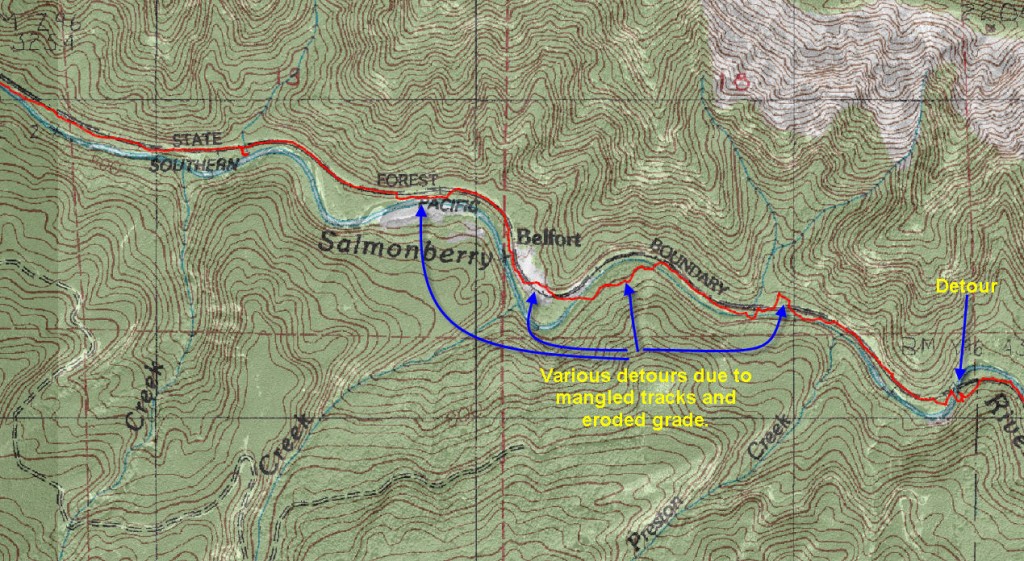
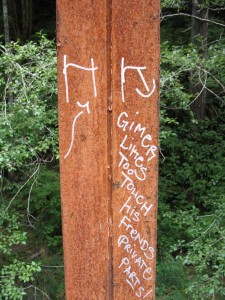 From the water tank in Enright it’s about 2 miles to Belfort and most
From the water tank in Enright it’s about 2 miles to Belfort and most 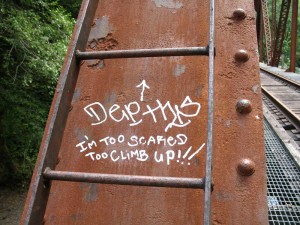 of the way is pretty open and requiring only a few detours. One mile beyond the water tank the railroad crosses the river and begins to follow the north bank. That bridge appears to have been the log book for our traveling taggers
of the way is pretty open and requiring only a few detours. One mile beyond the water tank the railroad crosses the river and begins to follow the north bank. That bridge appears to have been the log book for our traveling taggers 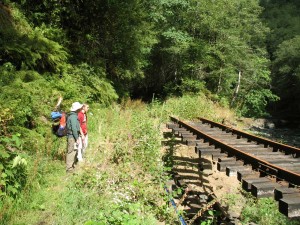 chronicling the signatures.
chronicling the signatures.
About a half mile beyond the bridge we encounter our last major detour as a fast flowing tributary has swept away part of the roadway. But beyond that the roadway continues relentlessly onwards towards the Nehalem River. It all looks so peaceful in the afternoon summer sun, but I can only image the ferocity of the water and the elements as they tore this iron and steel 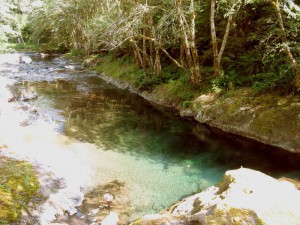 railway to pieces in 2007.
railway to pieces in 2007.
As the route progresses we see tall pinnacle peaks, and bare cliffs looming above the valley. But the river at this stage is becoming wider and is a long series of tree shaded pools inviting the tired hiker to shed his or her clothes and jump in…
7. Nehalem Confluence.
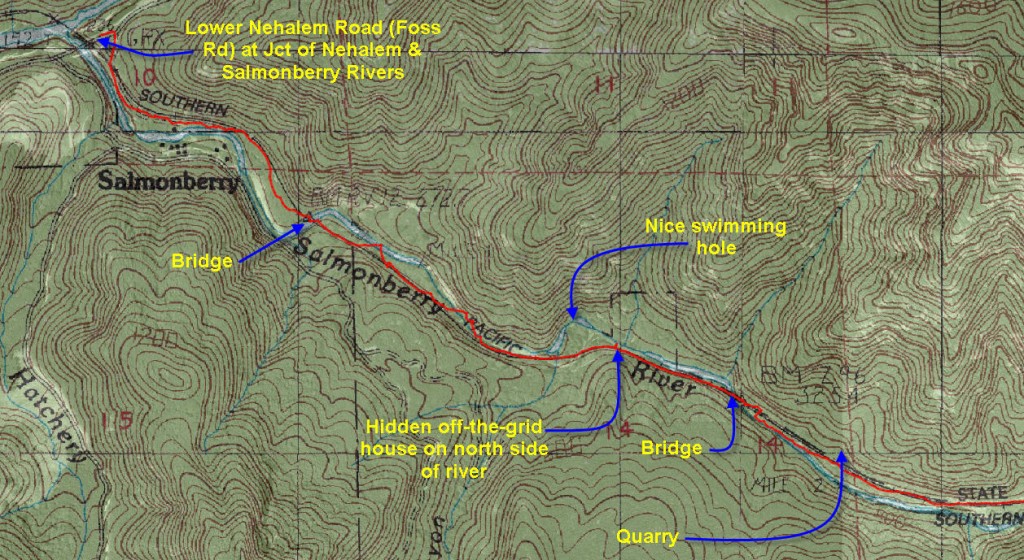 The final stage of the hike takes us from Belfort all the way to the confluence of the Salmonberry and the Nehalem River. Leaving the curve in the river that once marked the location of Belfort on the north side of the Salmonberry, we reach the quarry
The final stage of the hike takes us from Belfort all the way to the confluence of the Salmonberry and the Nehalem River. Leaving the curve in the river that once marked the location of Belfort on the north side of the Salmonberry, we reach the quarry 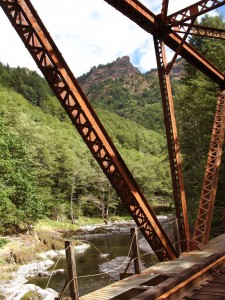 (about 1 mile from Belfort) that was used to procure all the rock fill that supported the railroad embankment until the river decided to reclaim its rocks. About a half mile further we cross the river once again and begin to track along the south side of the river.
(about 1 mile from Belfort) that was used to procure all the rock fill that supported the railroad embankment until the river decided to reclaim its rocks. About a half mile further we cross the river once again and begin to track along the south side of the river.
As we proceed through ever widening embankments, keep a sharp eye open for a steel cable strung between two trees – about a quarter of a mile beyond the bridge. When you spot it look carefully amongst the trees that line the opposite shore for a partially concealed home patched together with found materials. I would not recommend making a visit since the last time I was there I noticed a rifle leaning ominously against the front door. Perhaps it would be wise to honor their desire for privacy…
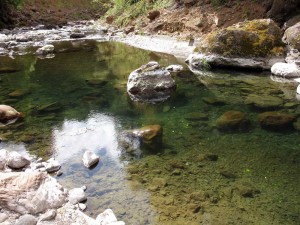 And anyway just around the corner is one of the best swimming holes on the river – and close enough to the terminus of the trail to provide a lasting refreshment for the drive out. As you turn the corner (track bends to the left) follow the tracks along until you nearly reach the narrow portion that bends to the right again. Just prior to that you will come across a small ravine that drops down the embankment towards the river. This is probably the best way to reach the shore. Once you’ve reached the river level follow the shore a bit upstream to where you
And anyway just around the corner is one of the best swimming holes on the river – and close enough to the terminus of the trail to provide a lasting refreshment for the drive out. As you turn the corner (track bends to the left) follow the tracks along until you nearly reach the narrow portion that bends to the right again. Just prior to that you will come across a small ravine that drops down the embankment towards the river. This is probably the best way to reach the shore. Once you’ve reached the river level follow the shore a bit upstream to where you 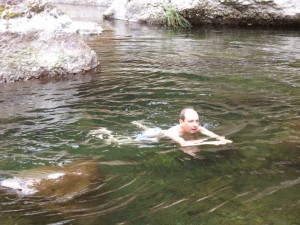 can see some nice pools interspersed by large rocks. A large boulder on the shore sits over a small patch of sand and offers a handy wind break if the afternoon breezes are too cool for your liking. Now shed clothes and enter the water either very quickly or very slowly – your choice. But once immersed this pool is next to heaven, in my humble estimation!
can see some nice pools interspersed by large rocks. A large boulder on the shore sits over a small patch of sand and offers a handy wind break if the afternoon breezes are too cool for your liking. Now shed clothes and enter the water either very quickly or very slowly – your choice. But once immersed this pool is next to heaven, in my humble estimation!
Returning to the railroads tracks, keep traveling west. About 2/3 of a mile onwards you cross the last bridge (note the “VRS” tag along the base of the bridge). Also notice the huge tree wedged underneath the bridge – look at it carefully and imagine what force it took to wedge it into that position. Just past the bridge you’ll come across two homes set along the north bank of the river. Shortly after that there is a track that angles away from the tracks on the right side. Take this route it will get you to the road quickly.
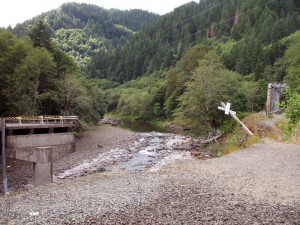 Be sure to look at the bridge over the Salmonberry that was also washed away by the 2007 flood. When I was out in August of 2010, I spoke to two engineers that told me the bridge would be rebuilt and opened in 2012. This hike ends at the Lower Nehalem/Foss Road junction. As seen in the nearby picture, the railroad extends over the Nehalem river and eventually reaches the coast at Wheeler – about 17 miles as the train rolls. This southern passage to the coast ends here, as all further travel is really part of the coastal plain.
Be sure to look at the bridge over the Salmonberry that was also washed away by the 2007 flood. When I was out in August of 2010, I spoke to two engineers that told me the bridge would be rebuilt and opened in 2012. This hike ends at the Lower Nehalem/Foss Road junction. As seen in the nearby picture, the railroad extends over the Nehalem river and eventually reaches the coast at Wheeler – about 17 miles as the train rolls. This southern passage to the coast ends here, as all further travel is really part of the coastal plain.
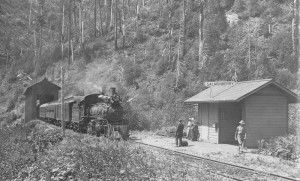

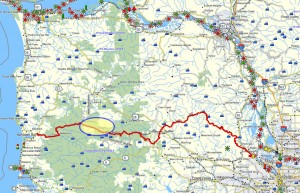
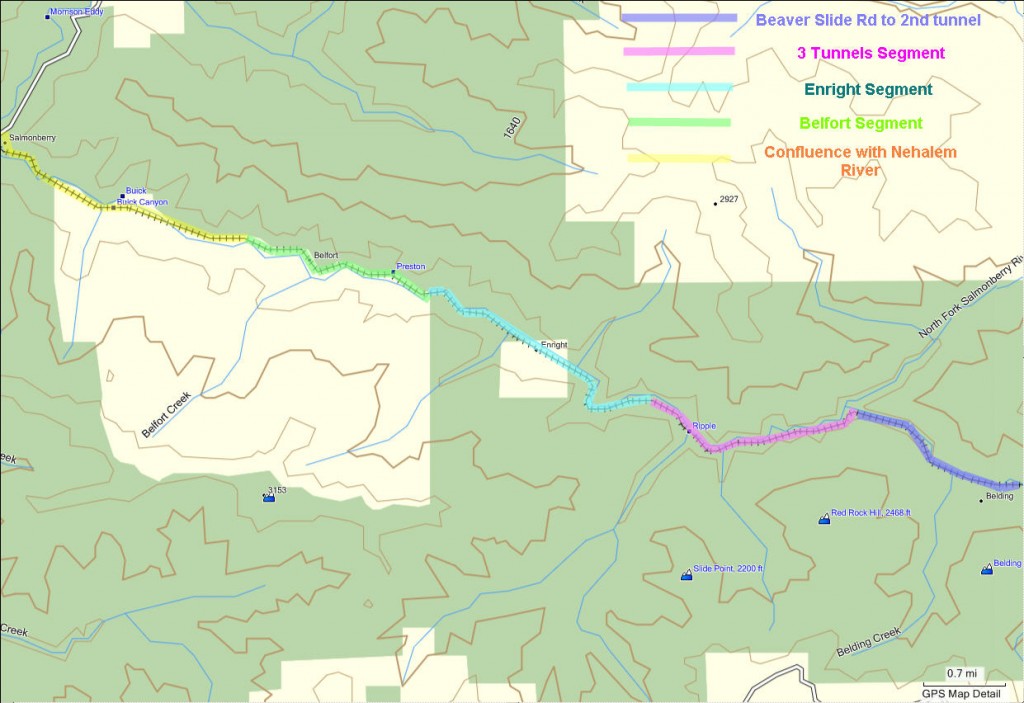
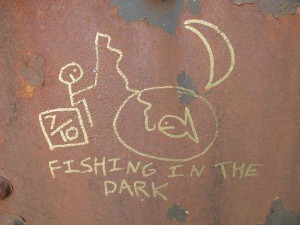
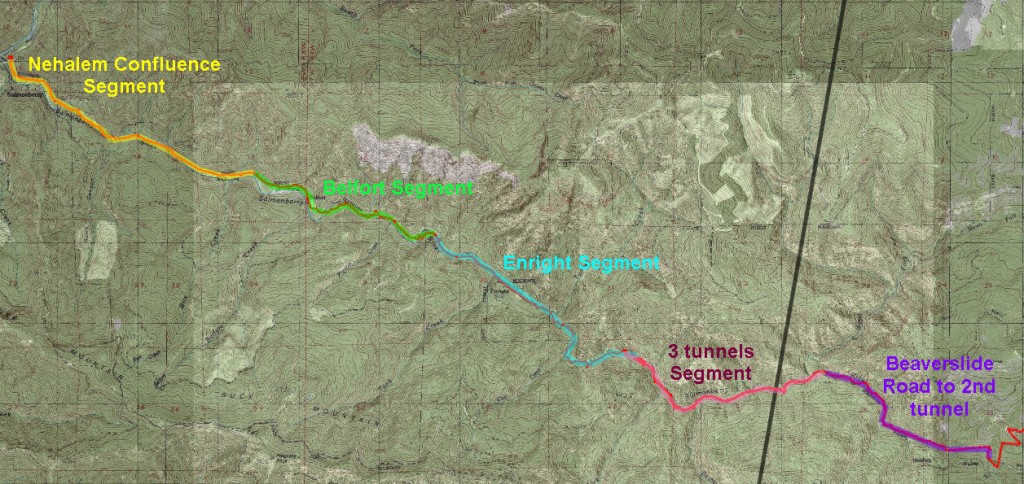
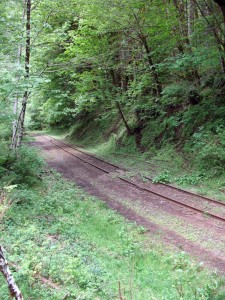
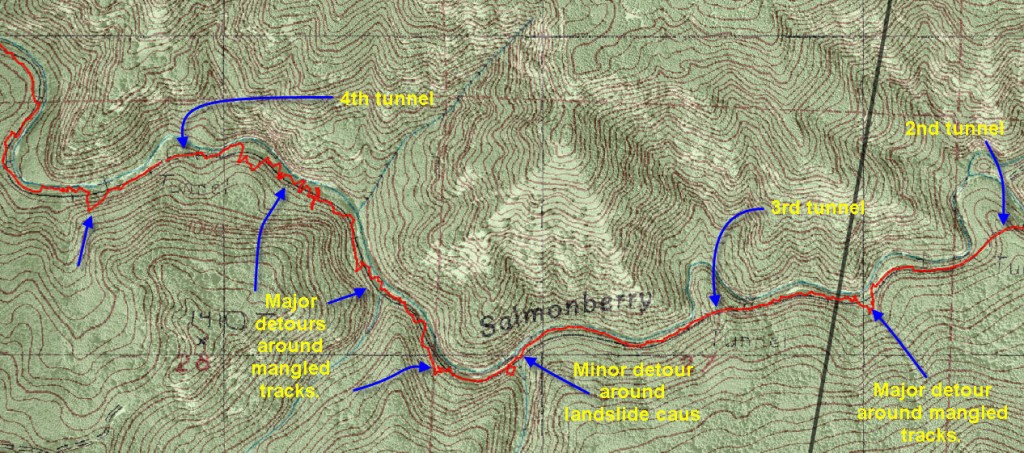
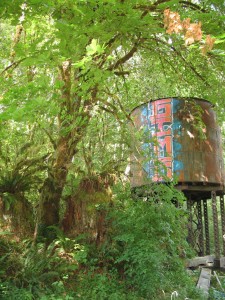
Nice photos, we’ve spent a lot of time out in that forest and along the river and its forks. One of my favorite areas, hope it stays barely accessible for us die hards 🙂
What an outstanding commentary. Thank you so much for a very well documentated trip. Your observations and reporting are extremely accurate. Once again, thank you.
My fathers uncle (Carlton Shirley). He purchased what is now the Don Hennig place along with the entire town of Enright except for one cabin after the burn. I can remember many weekends at his cabin in the early 60’s. My father later purchased a cabin about 3 miles up stream from Enright. We used to drive in from the Sunset hwy until the bridge was taken out that you speak of in 67. We then had to get to the cabin from Lees camp. In the early 60’s you used to be able to drive right down to the RR tracks via Jones road. Our cabin was about 1/4 mile down stream from that point. I spent many wonderful hours hiking the mountains around the cabin. At one point finding an old steam donkey above the cabin around an area we called the basin. I remember the town of belding right after it was raised. Old houses still stood at that time on the outskirts of town. We sold the cabin in 75 after my fathers passing. It soon became dilapidated and the RR took back the property.
My happy memories are all that is left of that time, and I am glad to have them.
Thanks for your thoughtful contributions. It provides a real flavor for the forgotten communities that once existed in this remote area. And today its getting ever more remote with the closing of the RR, and nature taking back what’s left. Do you have any pictures from those times. It would be nice to publish a little piece on your recollections if you’d like to share that. Jim Thayer (jim@thayers.org)
After having been to the end of Beaver Slide Road on a ATV trip earlier this year and seeing how remote and beautiful the river basin is (as well as knowing the destruction that was done to the RR), my oldest son thought it would be fun and interesting for the three of us (myself, his younger brother plus his dog “Boomer” and he) to hike the rail line from Reehers Camp to Foss Road. As stated in your posting of Sept. 18th, “It is getting more remote with the closing of the RR and nature taking back what’s left.” We feel it will not be much longer in time before nature takes it all back completly.
This of course would be a hike of just over 21 miles, not to mention the fact that I am 57 years old and my sons are 34 & 28 and none of us have come close to treking this distance before. So, at about 8am, Sept. 17th (the choice of the weekend was based upon my sons work schedules.) we started out on our adventure, which was with pleasure and misgivings. I say pleasure because of spending that kind of time with my sons, misgivings because of the rain and drizzle that followed us for two days.
By about 2:30pm we had reached our planned camp site at the end of Beaver Slide Road and after a restless, somewhat wet night of sleep and a quick breakfast we were back on the trail again by 8am – reaching the junction of the Salmonberry & Nehalem River by about 2:30pm – soaked to the bone of course. But I would not have traded those two days of being with my sons on such an adventure and seeing the wonder, beauty and destructive power that nature can unleash on a river first hand. If we were ever to do this again (which I hope next year), a two-night camp out would be best and of course much better weather.
Thats a great write up on the legendary hike down the Salmonberry. I target Winter Steelhead in there and have the pleasure of seeing it in all of its fury! The camping is great, and the scenery almost trumps the fishing! Almost! 😉 HA! Great read, and great info! Thanks for takin the time.
I’m new to the Salmonberry and wondering your take on the best places to set in for a great day hike and possibly a good spot to drop a line? I understand if you don’t wanna share the latter. Last time I gave out a good fishing hole every yahoo and his neighbor took it over… Lol. Either way, much appreciated and well wishes on your endeavors.
Hey! Sorry its been so long since ive checked back here! But it is getting to be that time of year where the big wild winters are starting to show! For a general hike in for a single day trek, i like the jaunt up from the confluence with the Nehalem, on up to about Enright. If i were to fish, which is about my sole reason for exploring this time of year… I love starting at about the 6 mile marker and working my way out to the second bridge. If i have time, so.etimes i can get that pocket water in between the first and second bridges. But normally i like the 2nd to about the 7th or 8th mile of river. It gets really hard to fish the canyon stretches above there. And its easier to come in from Beaver Slide if you want to fish that high anyways!
Easiest way is via Foss road. Walk east at the bridge nice swimming holes close up river. Jim
Jim,
Don and I both enjoyed your article on the Salmonberry River. As you remember we have met prior and own the cabin at Enright. We do enjoy sharing the Salmonberry with hikers although I must correct a part of your article where you state that there is a good camping site past tunnel 32. The site you mention in the article is private property and has been posted no camping due to fire danger. I had once come in right after someone camped and found a smoldering fire with log going into the forest. I was able to put fire out before it started a forest fire. We had to post the no camping sign and no camp fires. Please direct hikers and campers to not camp on private property. Please hikers abide by the no trespassing signs. Next time you are in stop by for cinnamon rolls. We are in frequently. Thank you for you consideration.
Don and Diana Hennig
Don and Diana:
I was unaware that the location I noted was posted. I actually did not stay on that spot, but spend the previous night sleeping on the tracks about a quarter mile east of this tunnel. But when I did see it, it looked mighty inviting – so I can understand why you’re waging an ongoing battle to keep people off of it. I may take you up on your offer some day. I hear that the bridge at Foss road is open again, which means I might actually be able to drive fairly close to you.
I have edited out the sentence that suggests camping on your property. I hope that helps!
Jim Thayer
Hello Don and Diana,
35 years ago my father, Ralph Neumann took me up to your cabin. Harvey(Harveys Cleaners)and “Charlie Shoot Two” were hunting partners at that time. My dad was always ready to hunt, cook and have a good time with you guys.
Good to hear your name,
Roy Neumann
I read that the private property line is actually along the railway and south. Meaning all land north of the tracks is not private property, including said camping spot.
I read that the private property line is actually along the railway and south. Meaning all land north of the tracks is not private property, including said camping spot.
I have seen the property ownership map and there is private property to the north of the RR lines. You information is generally right, but not correct in this case and generally not correct around the western end of the line in the Belfort and Enright areas.
Don and Diana:
It’s been awhile, but I’m still busy scouting out logging roads on Buck Mountain. I’m trying to identify both existing and/or accessible routes down to the proposed trail from the logging road network that crisscrosses the heights. I believe I have located the barrier that leads down to your cabin.
I would like to ask your permission to enter the gated area to ascertain that we have located the upper access road into Enright. Later this spring, Parametrix, the engineering company doing the scoping study on the “canyon portion” (Cochran Pond to Mohler) of the trail would like to use this access so that they can focus on the upper stretches of the river.
Would you be willing to grant these three engineers from Parametrix permission to cross your property to reach the PR&N tracks?
BTW, do you know the elderly gentleman that lives on Cronin Creek. Mr. Stewart (forgot first name) reputedly logged most of Buck mountain – which I tend to believe based on the fact that he still has a functional “Huey” (helicopter ) parked in the little compound up Cronin creek?
I hope this email finds you both in good health and fine spirits!
Jim Thayer
I see a tin shack road running east just after the Nehalem/Salmonberry intersection. Is this forest road passable? I suspect not. Looking for a back country route that goes from 26 to 6 for a dual sport ride.
Thank you for your consideration. We enjoy sharing just not camping on private property due to liability issues. Hikers are welcome to visit us and stop for refreshments.
See ya on the Salmonberry River,
Diana
Diana,
Am I to understand that you now own the little cabin on the Salmonberry? It would be a pleasure to see it if it were available for viewing. 🙂
Jen
Diana Hennig writes: “Yes…The cabin has been in the family since 1965. What do you mean available for viewing? Which cabin?”
Diana
Please reply via this forum.
Jim Thayer
I just hiked the beautiful section from the North fork to Enright and back. The track’s condition is a lesson about the unstoppable power of water. Thanks for the exceptional description and recent and historical photos.
If one traverses the Berry and is not touched and in awe… they simply have no soul.. by the way, if the coors light drinker reads this… pick your cans up… they make my fishing gear smell like a rodeo- Brad
Jim – I saw the your segment on TV the other night and I’m glad I did. I am fascinated by the section along the Salmonberry. Beautiful natural scenery plus abandoned human works – a great combination. I have spent the last two days looking at your website description and scanning Google Earth. I am going to do this section. I am thinking July or August when the water is down. This should allow for stream walking and wading around rough sections and, hopefully at least, the water somewhat comfortable for a dip. I’m thinking to hike up and back from the Nehalem. Since I really just want to explore, enjoy and poke into everything, I’m thinking a two night trip up and back would be great fun. Do you think that would work for a trip from the Nehalam up to the Belding Road/Tunnel 28 area?
Thanks for all your efforts.
Byron
Byron:
Two nights is sufficient to get to the Belding Road/Beaver Slide Road area and back, but that really only the lower half. The upper portion with the splendid trestle at Baldwin Creek and the washout at Wolf Creek are also worth seeing. You can either add another day to reach Baldwin Creek before returning, or plan another day trip from Cochran Pond to see the upper portion. July and August would be ideal for water levels – as long as we don’t get any fires in the area. Jim
Great post! I’ve referred to it a few times and finally went to the Salmonberry for the first time today. No steelhead in there yet, but soon!
I was intrigued by the – as you put it – “off-the-grid cabin” on the north side of the river. Before we came upon it I smelled a fire and sure enough, there was smoke coming out of the chimney of the cabin. Have you heard who lives there? And do they live there all of the time? Very interesting.
Aaron,
Those early return fish are still out in the mainstem. A few have been seen milling around the lower end of cook creek and a friend has just started having encounters a ways above the bait deadline.
Wait until late December for serious numbers. We often find the humbug, and wolf creek fish will be at the mouths before the new year. Which means they are in the river staging, and leisurely traveling for a couple weeks, or more, before that. See you out there I hope!
Way, way too verbose. II found your descriptions and driving directions to be nearly indecipherable. Please, please take out the extra verbage and be a bit more direct. Thanks anyway for sharing.
Agreed! I’ve tightened up the driving instructions, and will be doing a major condensation of this trail description as part of turning this into a chapter of my planned trail guide. I’ve done some needed editing, but there’s more to come. Jim
I am a Military Veteran and very interested in rails-to-trails projects. I see the the Oregon Legislature wants to direct the Parks Dept to look into turning the Salmonberry into a “real” hiking and biking trail. Typically, there is a lot of resistance to these sorts of projects and I won’t go into that now. Suffice it to say that I am an old man and will likely be long in the ground before any of this happens.
However, to amuse myself and to keep busy and healthy, I like going out to remote rail lines and documenting their condition and posting pictures that entice nature lovers to head on out and see for themselves. I hike in remote locations because I don’t like people much but the locals I run into who live in these rural settings tend to be a lot more to my liking. “Real people”, so to speak.
I’d be interested to hear from some of the folks who post and visit this blog as I do my research on this project. I am a “leave no trace” hiker and strongly promote this philosophy on my web site. My contact info is on my web site if you want to chat directly.
Excellent job Jim, BTW. I agree that a little editorial clean up would be helpful but this is still one of the best trail reports I’ve ever read. No small task considering that the Salmonberry looks to be a difficult, lengthy, complex and challenging endeavor. Very much appreciate your efforts Jim!!!
“Real people” I like that! And I agree!
Fantastic article Mr. Jim!! Can’t wait to explore it all!!!
Hi there Jim!
What a delight to happen upon your web site this evening! I am planning a return trip to one of my favourite places yet and am so delighted to find your writings, and MAPS!!!
I reside in Vernonia, and adore the access to logging road hikes just outside my door, but the beauty that you write of keeps me , and my trusty mutt Tucker, to the Lower Salmonberry River. ( his favourite gear is four paw drive through the woods!)
I am quite intrigued by your maps! Thank you for all your time, and efforts in keeping it all straight for the rest of us!
Victoria
I left a small report last week on your “Upper Salmonberry River” hike about conditions on the entire trail. In it I pointed out that despite the alders taking over where ever sun light falls, the hike is easy to follow. The trails going into the forest to bypass river or creek damage to the rail bed are not that difficult, and even some kind persons have left rope in one place and a ladder in another to help the scramble up and down the steep banks.
I wanted to thank you for your well documented guide for both sections. It was helpful in planning my trip and gave me a gauge of distance. The gauge of time of course was my own, sometimes spending a lot of time in one place and moving along at a good clip in others. I appreciated the old photos and the history, the only striking irregularity were the numbers of the tunnels. Someone has spray painted 35 on what you call 31. I only saw them in three consecutive tunnels, those all on the west end. It would also be nice to know about Native American history for this area, and I am sure that with a little research some very interesting things could be learned.
The use of this river watershed in the future is going to be very difficult to handle. I can see a proper trail developed to escape the monotony of constantly treading on the ties and to open up access to more people, and all the problems those people will bring with them. Problems of pollution, overcrowding and safety. And I can see leaving development alone, letting those who seek adventure, risk and beauty to find it because of the remoteness and difficulty of access. The railroad has cleared and repaired the tracks for two miles upriver from the Nahalem towards Enright, and three more miles to go before reaching there. What impact will that have on the hiking experience? And for me another really big issue, how much of the rail can or should be returned to use.
Since most of my hiking takes place in the Cascades, the ever increasing numbers of people there have changed these trails for the worse, I am so sorry to say. There needs to be places of wilderness and solitute and the Salmonberry is one of these places. This will be hard to do because as I pointed out earlier, this hike is not that difficult to do. So, I will leave my last thought for you. How do I share a place I love with people who should see how truly wonderful it is and yet keep it all to myself. The answer is easy.
Thanks, that kind of new information is always welcome since it’s hard to keep the more than 65 trails on this site constantly updated. Especially, when I’m busy writing the next book.
Does anyone distance from the end described here to Nephlem? Ie hike to coast.
From the confluence with the mainstem Nehalem, it is approximately 30 river miles to the jetty. Not all of it is accessible via the tracks. As you get closer to the ocean, you may have to hike the highway system.
Thank you for the detailed write up! We were wanting to do this as a backpacking option, but also want to respect property rights. I see it’s been a couple years since anyone has posted, but do you have suggestions on where to camp near Enright? Are the property lines clearly marked in that area?
Any suggestions would be appreciated!
The part that’s private property, as far as I can tell from the owner’s description is North of the tracks, along the shore and accessible from the lower end of the tunnel. The area to the NE of the tunnel is RR land that you can use. We often just sleep on the tracks – a bit uncanny when you’ve got a railroad rail for a pillow…
Enright is now used and owned by the Karomanos family AKS Sunshine dairy PDX.
Great area and beautiful river.
Wish the Port of Tillamook would clean up all the old R/R mess
Once the actual work on the trail building begins much of this will be cleared away. It is still unclear whether the excursion train will reach all the way up to Enright. If it does, it will obviously require at least one set of rails.
Several days ago I made it down the North Fork almost down to the confluence with the main stem, but my partner was not keen to go scrambling over the several side streams that crossed the “path”. Beautiful down in there.
We took a 14 ft paddle raft down the Salmonberry I 1995 with 4 intrepid souls. We launched at The North fork confluence and made it to the mouth just at dusk on a cool January day. At that time the RR was still in operation and we made a stop at Enright and visited with Diane? who was staying at one of the cabins there.
In 1997 we revisited the Salmonberry with two catboats, an oar raft and a kayak this time launching at Beaver Slide. Rototiller rapid had a log part way across the route and we had to bump over the pile of whitewater on the left side. We ran into a small river wide logjam just below the North Fork and it caught two of the rafts and flipped them. We portaged the remaing raft over the logs and eventually caught up with those who swam. No injuries, luckily. The epic adventure had more flips, train rides, lost boaters, and rafting after dark. Too little daylight in January given the long shuttle.
I scouted the river in 2013 for another trip but the number of logs and crucial navigation to circumvent them made rafting the river too dangerous that day. Maybe some big storms have cleared it out for a reasonable rafting run. Scouting it prior to running it is the only sure way to know.
We still talk of our adventures on the Salmonberry.
Thats really neat! I did float the Salmonberry once in 2004, right after a big snow melt year, and once again in 2008. Scouting is absolutely required, and portage work is almost always going to happen! 2012 laid a lot of timber into the river, and it still isnt totally clear. But with another El Nino cycle in effect… I have a feeling she will morph once again, and hopefully spit some of those toothpicks out to the Nehalem! I am in the process of building a narrow frame, two person raft, for the ‘Berry, and the North Fork Nehalem. Done the NF in my drift boat a lot… But want something a little more fun, and able to survive the Salmonberry in all of her fury! Keep the group posted if you wind up scouting for another drop in!
You are one brave soul! NF in a hardsided boat!! I have heard from good authority not to even think of such a thing haha
Book version now available! Also maps for all these hikes downloadable!!!
Please note for all of you that have been following this thread about clambering down and in some cases floating down the Salmonberry – this entire stretch is now described (and more thoroughly edited and one contributor suggested) in my new book, Hiking from Portland to the Coast.
Unfortunately the publishers put the maps in with a horizontal alignment – they’re really small and require a magnifying glass to be able to read. So I have made them available for download as a printable .jpg for $1.00 each – except where there are two maps associated with a single hike then I charged only $.50
Belding Road Reconnaissance is proving to be quite challenging.
The Belding Road is actually the southern end of the road that used to cross the Salmonberry at the confluence with the North Fork of the Salmonberry. The bridge abutments are still visible, but the bridge was removed in the fifties to prevent folks from driving over the river.
So, according to my maps there was once a road that connected with the Beaverslide Road (river crossing elevation at about 880 ft) and climbed the slope on the south side of the river, eventually connecting with the Standard Grade about 2,000 vertical feet above the river. The original entrance to this road from the Standard Grade would have been from that convoluted clearing/intersection where Gilmore Road connects with both Belding Road and the Standard grade, and also with the road heading west to Tin Shack Road and Cook Creek. On some maps it’s marked as a “borrow pit”, but it’s a major junction that connects all the long distance trails in this area. This intersection is located on the spine of a ridge that separates the North fork from the Middle Fork of Ripple Creek. There is a marker there that indicates the top of Belding Road.
Oh, if life weren’t just that simple…But a massive rock slide has made this route impassable – even to those willing to scramble through vine chocked and rock strewn slopes. The far side of the slide is a sheer cliff. So now I’m going to try to approach it from further north on the Standard grade, where I recall seeing signage pointing to (what I presume is) the “new” entrance to Belding Road. I once measured the loops and twists of Belding Road to determine that the descent is about 11 miles long and there is no other exist (on the South side of the Salmonberry). So getting out is an 11 mile slog back up the road you just descended. Nobody has been down this road for years so it should be quite an adventure. Expect to see me out there on a clear day so I can lighten my load enough to make the journey quickly. It’s a bear trying to climb this slope with a loaded back pack…
I came to the same conclusion you did – better to explore Belding Road from the north. I walked across the Salmonberry at the bottom of Beaver Slide and spent a couple hours exploring Belding Road. I spent most of my time bushwacking around the fork off Belding Rd that goes to the west, down toward Belding Creek. That spur down to Belding Creek is missing a large chunk due to a big landslide which required a lot of bushwacking to get around. So to answer the question on your map about Belding Creek being an access point to Belding Road, I would say no.
Belding Road itself is easy to walk on. I posted a few photos to give you an idea of what it looks like at this site: http://www.raftalot.com/beldingRoad
Thank you for all the work you’ve done on Forest Hiker all these years, I’ve really enjoyed it.
And for rafter Tom Riggs – there is way too much wood in the Salmonberry above the North Fork which isn’t going anywhere soon.
For anyone interested in what the Salmonberry looked like in 2011 and 2012, take a look at http://www.raftalot.com/salmonberry2011 and http://www.raftalot.com/salmonberry2012.
Can one still access the lower Salmonberry Trail from the area near the confluence with the Nehalem river?
Yes, It is possible to walk up the north bank of the river from the Foss Road Bridge. The RR line crosses and recrosses the river as you ascend. I do have to add the caution that the Oregon Parks and Recreation Department (OPRD) and the Oregon Department of Forestry are now both involved in managing the enormous task of restoring the 15 tunnels and at least 15 trestles so they are discouraging users from using these unimproved and frequently partially collapsed structures. But, truth be told, it is possible to ascend all the way from the Foss Road Bridge to the junction with the North Fork of the Salmonberry River, to Beaver Slide Road or even all the way to Cochrane Pond. It’s about a two – three day walk all the way through – depending on how much time you spend dawdling in the pristine swimming holes along the way.
Alternatively, you can “follow” the Salmonberry by ascending the “Standard grade road” that is accessible from the summit of Highway 6. There is a difference blog (on this site) on accessing this route. Much recommended as a bike ride, even with standard city bicycle.
Enjoy
Jim Thayer
Hi Jim
I was under the impression from a few other sources that this trail was now closed to the public [http://www.oregonhikers.org/field_guide/Lower_Salmonberry_River_Hike, http://paulgerald.com/portland-hikes/salmonberry-river-update/%5D. Can you correct me if I’m wrong? I absolutely love the trail and I had been hoping to return here soon with friends and family.
Thanks!
What a change, I use to spend a lot of time In that area in the 80s and 90s. Use to catch really nice trout in Cochran pond and a lot steelhead in the salmonberry. Would ride my 3 wheeler up and down the tracks back then.